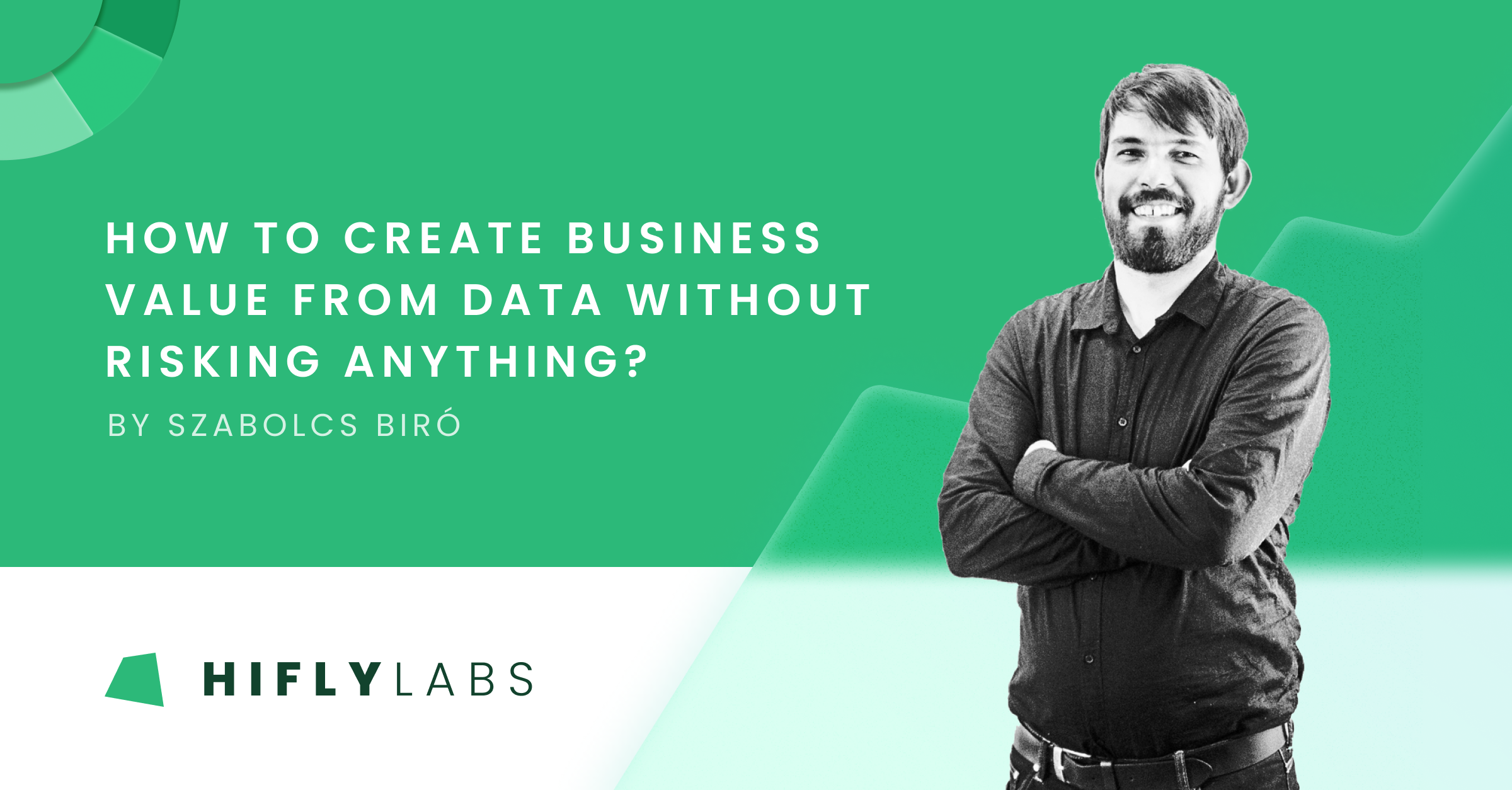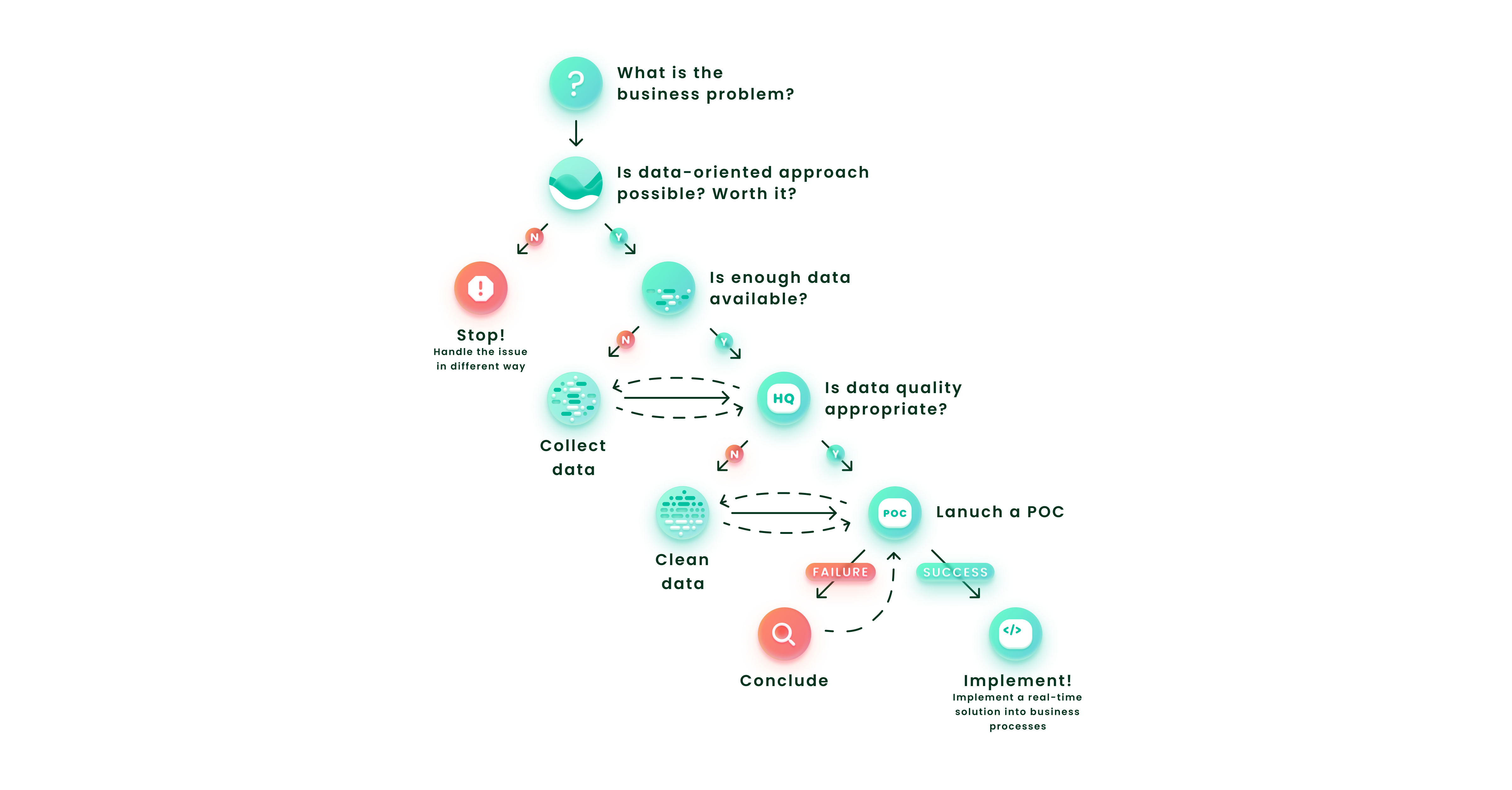Reading time: 7 min

I’m probably not telling you anything new when I say data is already the oil for company development and will be even more so in the coming decades. Growing your business, increasing customer satisfaction or analyzing if there are any upcoming threats at a sustainable pace is impossible without implementing data science techniques. The question rather is: what is the right technique for data projects? How can you check the feasibility of a solution and assess its business benefits quickly and cheaply – before implementing anything?
The answer: A Proof of Concept (POC) based approach is the way to go!
This article will not only help you understand what a data science POC is, but it will also introduce you to the exact steps you need to follow in order to fuel growth without risking anything!
Risk-free & cost-effective – The right way to create business value from data
Data science is an essential part of any industry today, given the massive amounts of data being produced. Nevertheless, as a company providing successful data solutions in various industries, we often encounter confusion among our customers about how to apply a machine learning (ML) based solution to a business problem (or even how to give data-oriented support to an entire department or a company).
It is important to know that analytical initiatives are often pilot projects entailing that their success and added value are difficult to predict at the beginning. Therefore, if we do not approach such an initiative carefully and with the proper methodology, the project can fail easily for a variety of reasons (e.g., no data, poor data quality, or simply due to a business issue that can not be modelled, etc.).
The result?
Business decision makers will think of the project as a negative experience and will feel a deep regret about throwingmoney out of the window.
So then: is there a better way?
Yes, indeed!
The best way to approach these projects is by: defining phases with gradually rising investments, which in return will mean an increasing guaranteed ROI (Return on Investment). Based on our 20 years’ of experience, the best solution is a Proof of Concept based approach that can and should be used at any level of data maturity.
What is a data science POC?
I am sure you know the meaning of “Proof of Concept” (just in case though: mini-projects that explore the feasibility of a system, product or service and its business benefits quickly and cheaply). But what does running a POC specifically for data science mean?
In this case, a Proof of Concept helps you evaluate the value, relevance and feasibility of different data science solutions before they are implemented. A data science POC should always prove that a given system will provide widespread value to the company: that is, it’s capable of bringing a data-driven perspective to a range of the business’s strategic objectives.
In terms of advantages, this methodology helps you with:
- Saving time and money by sustainably allocating the resources of the company only towards those projects, which will reliably create value.
- Ensuring that the given solution meets specific needs or sets of predefined requirements.
- Becoming a data-driven organization from the core.
- Receiving timely and valuable feedback from various stakeholders.
- Giving your team the opportunity to get comfortable with change.
Plus, just some of the indirect advantages of a POC include:
- POC connects experts from different areas and helps them get a better understanding of processes, verifying or rejecting hypotheses.
- Colleagues, who participate in the project, can get a better understanding of dashboard tools or predictive methodological processes.
- POC helps the team ask the right questions and transform these into “data language”.
- It helps to change even strong opinions once they turn out to be false.
How to run a successful data science POC?
Let’s see what are the 5 essential elements of an efficient data science POC which can help you keep your project on track!
-
Set up a team consisting of the right people
I know, it sounds obvious, so who exactly do I mean?
To run an efficient POC, you need to include people from all parts of the organization in your team.
- Data scientists and/or analysts will definitely be connected to the project.
- The IT team will also need to test the solution’s feasibility.
- Furthermore, any business teams involved with or impacted by the results of the project
- as well as end-users of the solution should be involved.
However, be careful you don’t swing too far in the other direction and involve too many people, as this can slow down progress and efficiency. A few representatives from each team or group is generally sufficient.
-
Define data-related business problems
Now that your team is set up, the next and probably most important step is the definition of the business problems.
Ok, but how?
Try to gather ideas together with your team for a variety of business issues. Once the list is complete, find the answers to the following questions:
- What does the current process look like?
- Would the use of data in general or data science/machine learning techniques help with this business issue? If so, how?
- Do you have the necessary data for a POC?
- Where is the data stored?
- Are you willing to work on this use case with an external partner?
- Will this use case help you make money, save money, or realize any other benefits?
The outcome of this step should be the definition of testable ideas (hypotheses). For example, the risk of churn can be determined by using customer data and past behavior patterns.
-
Select business problems for the POC
Regardless of the sector, there will be several business problems for which a data solution is conceivable. However, there is no capacity to develop a solution for all. Ideas should therefore be prioritized. Thus, your next step is to determine for which idea(s) it is the most worthwhile to start a POC project.
In our experience, there is no obstacle to running multiple POCs in parallel (if you have the capacity), but you should expect these threads to run independently. The big advantage of this is that you have a better chance of success, at the same time the downside is that attention is divided.
If capacities are low, it is worth considering speed when prioritizing the ideas. For example, you could define POC projects for business cases where you can validate the possibilities and pitfalls of an analytical solution relatively quickly.
-
Set up clear deliverables
In order to restrict a POC to a reasonable timeframe, you have to set up clear deliverables. Without them, no one can be really sure what to consider done or what to consider a success.
Ideally, the final deliverable is the implementation of a data project based on the selected use case. However, it’s also worth setting up deliverables/milestones along the way. For example, individual teams could set up checkpoints to evaluate their subset of the project.
-
Know when to stop
The idea’s been tried and it brought the expected benefits?
Excellent! It’s time to move on to implementation and incorporate the results into your day-to-day operations.
However, if the result is the opposite, don’t waste more resources on it! Draw conclusions and use them in the next idea.
The best solution is to make a GO / NO-GO decision at about the third of every POC project.
This way, the process of developing a data-driven solution can be simplified and risks can be reduced. Use the following decision tree from the use case idea to day-to-day implementation:
Conclusion
Data science projects are complex and it is always a question whether they are feasible or not.
A Proof of Concept is an excellent way for businesses to evaluate the viability of an idea and sustainably allocate their resources towards those projects, which will reliably create value.
By following the above steps and choosing the right partners for your project you can ensure a smooth and successful POC and allow your organization to move to implementation quickly while saving invaluable resources.
Interested in getting a great amount of valuable data insight, but not sure how to start? Book a 20-minute discussion with one of our experts to help you get started!
Have you got experience with data-based POC’s? What are your best practices?
[We are curious about your opinion: what do you think are the top mistakes businesses make when running a data science POC? Let’s chat about it in the comment section below!👇]
Authors:
Szabolcs Biró – Head of Advanced Analytics
Ákos Matzon – Advisory Team Leader

